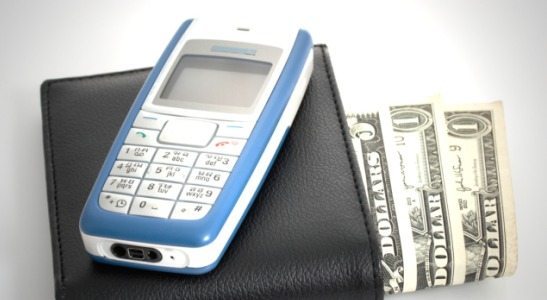They’re not here yet, but expect mobile payments to change the way we pay
If your wallet feels thinner in the upcoming months, blame your cell phone, not the down economy. Mobile payments, also called mobile money and mobile wallet, are the future of commerce. If they haven’t already, mobile payments will soon revolutionize the way you receive, spend and monitor your money — no plastic required.
Instead of swiping a conventional debit or credit card when you’re at the grocery store or out to dinner, mobile payments digitize the process. Simply open your smartphone’s finance application and tap your cellphone on the checkout counter’s PayPass terminal.
Voilà, the transaction is complete.
Your cell phone, operating a technology called Near Field Communication, uses a semiconductor chip housed in your smartphone to transfer the payment from a pre-paid or credit card account with the application. Though not many existing smartphones possess NFC technology, few released in 2012 won’t have it.
LG, Panasonic, Microsoft, and Toshiba say they plan to incorporate the technology in their phones soon. Motorola, Samsung, Nokia, BlackBerry and Android released smartphone models with NFC chips in 2011, but most don’t yet have compatible applications on which to perform mobile payments.
Google Wallet, the first major NFC-enabled mobile payments application in America, is only operational on Sprint’s Nexus S 4G (also created by Google), using Citi Mastercard. Naturally, Google plans to support more payment and phone types in the future.
Tailing by a hair, Verizon, T-Mobile, and AT&T plan to launch ISIS — a similar mobile payments system — later this year.
Alas, though the future feels so close, your reimbursing cell might still take a few years, according to a study released by Gartner in July.
Gartner estimates that 50 percent of smart phones will be NFC-enabled by 2015.
“We believe mass market adoption of NFC mobile payments is at least four years away,” says Sandy Shen, research director at Gartner. “The biggest hurdle is the need to change user behavior by convincing consumers to pay with mobile phones instead of cash and cards.”
So, though financial institutions and software providers race to offer NFC, most customers are too accustomed to contemporary payment forms, Gartner speculates. A main motive for consumer hesitation is financial security.
David Peterson, founder of electronic payment software provider Goldleaf, says that fortified firewalls and other electronic gatekeepers make mobile payments quite trustworthy.
“NFC works only for a very small distance, say a few inches,” Peterson says. “By narrowing the field in which NFC works, it enables individual transactions with more accuracy and privacy.
“And, if I lose my phone, I can go to my computer and kill it, remotely,” he says. “I don’t care where it is or who’s got it – I can wipe out anything.”
Despite protective measures to stop fraud from occurring, what if the inevitable happens? Should a customer dispute a mobile transaction, unfortunately, there are only limited regulations regarding liability … for now.
Depending on which application is used and who the provider is, customers have different levels of protection.
“People need to be smart, because there’s not been a new prudent body of law saying banks or apps have to offer specific protection,” Peterson says. “If a customer has issues with stuff going on with a bank’s mobile payments application, then there are not any separate regulations that covers them than if they were online, or frankly, in the bank’s lobby … But any time a purchase is made bypassing the bank with a service provider, consumers and businesses should assume that there is not much protection of liability.”
For banks, customer liability isn’t the biggest problem. It’s staying modern.
Companies who have successfully created NFC mobile money applications, like Google Wallet, will determine banks’ and financial software companies’ relevance in the increasingly pertinent world of smartphones.
Eric Haler, retailer market manager at Bank of Arizona, says that after Bank of Arizona developed its iPhone, Android and iPad mobile banking applications last year, they quickly became indispensable.
“It’s definitely been good for business, and is certainly something clients like to have,” Haler says. “Now, for customers, it’s an expectation instead of a luxury.”
However, like most mobile money applications, Bank of Arizona’s does not yet use NFC technology, and customers’ smartphones cannot be used in lieu of a credit card.
“I haven’t heard of anyone leaving their bank over that or even really needing that feature, but obviously a lot of people are using it and it’s growing so it’ll be important to see that we keep up,” Haler says.
Keeping up, however, is an enormous undertaking. In today’s world of fleeting modernity and ever-evolving technological horizons, it can be hard to know in which direction to shoot.
Some companies, skeptical of NFC’s practicality, are skipping NFC entirely. Instead of following the latest trend, their finances operate with cloud computing.
Scottsdale-based Apriva LLC, a mobile payments processing and security service provider founded in 1987, says it looks ahead of NFC for the future of mobile commerce.
“Many people believe it’s going to grow rapidly over the next 50 years and become an important page in technology’s history. But today, it’s a just fraction of the market,” says Paul Coppinger, Apriva’s president. “Yes, our applications work with NFC, but the deeper end is they don’t have to use NFC. We’re independent of that fact, because our wallet isn’t built into the point of sale or phone, it’s in the cloud.”
Cloud computing, a wireless system of sharing via servers and the internet, doesn’t require additional hardware.
“With NFC, if you want advanced mobile payments capabilities, you have to get a special phone with NFC in it and merchants need to use it, too,” Coppinger says. “When you take all those special things and net them together… it’s impractical.”
Whether NFC is fleeting or conducts your finances forever, mobile, contactless payments are imminent.




